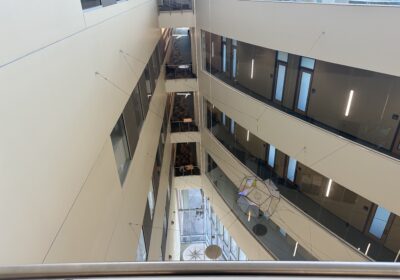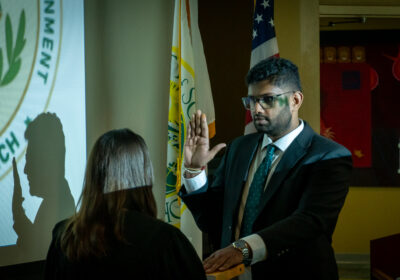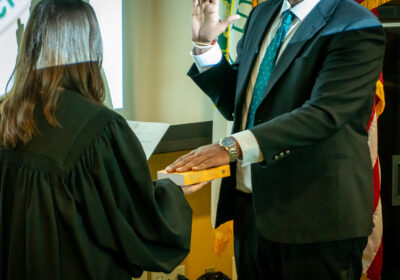USF research team witnesses historic eruption

SPECIAL TO THE ORACLE
For the first time since 1905, the Momotombo volcano in Nicaragua erupted in December 2015.
The eruption began on Dec. 1. A team of USF researchers made it to the volcano on Dec. 6, and on Dec. 7, it exploded in front of them. These researchers are currently monitoring the recently active volcano using radar equipment and lava flow models.
“It got everybody’s attention,” Chuck Connor, a USF professor of geology, said.
The Dec. 1 explosion caused ash to rise one kilometer above the crater. From Dec. 1 to Dec 2 there was slow-moving lava flow and ejections of tephra, airborne accumulations of eruptive fragments, according to data from the Instituto Nicaraguense de Estudios Territoriales (INETER) and weekly reports by the Smithsonian Institution Global Volcanism Program.
INETER, whose volcano investigations are headed by USF alumnus Armando Saballos, is an agency of the Nicaraguan government that monitors the natural hazards that plague Nicaragua, such as volcanoes.
“This volcano has been inactive for a long time but it’s a big volcano,” Connor said. “Although 110 years sounds like a long time for us, it’s not that long a period of dormancy for a volcano.”
Momotombo has a violent past, having erupted shortly after the Spaniards arrived in Nicaragua in the 16th century and remaining active throughout the 19th century. It erupted in 1905 after another period of dormancy and then went quiet until 2015.
“It’s had signs of activity, intermittently,” Connor said. “The vents at the top of the volcano have always been pretty hot. We measure temperature of about 800 degrees (Celsius).”
However, it is hard to predict the eruption of a volcano,
especially those that have been dormant for a long time. When they fall into dormancy, people stop monitoring.
The eruption forecast is based on monitoring, but according to Connor, INETER was short on funding and unable to keep watch over Momotombo.
“We didn’t get such good warning about this one until the first explosion,” Connor said.
Lis Gallant, a graduate student in geology, noted that in places like Hawaii, volcanic activity is heavily monitored, which allows them to locate the exact site of an eruption within several meters. This isn’t the case, however, in Central America.
Some USF faculty are working to improve monitoring in Nicaragua, including Stephen McNutt, Rocco Malservisi and Glenn Thompson, using instruments owned and managed by USF.
“The academic mission is to understand … the physics of the volcano and how it works, and it can play a real vital role for society, as well by helping them better forecast the eruptive activity when it does happen,” Connor said.
Gallant worked with Timothy Dixon, a professor in the USF geology department, and Laura Connor, a research assistant in the department, using a Terrestrial Radar Interferometer to make 3-D scans of the volcano to track changes, almost like watching the volcano breathe.
Gallant was also trying to track the velocity of lava flow to see if there were any changes. Her work focused more on research than monitoring.
Jacob Richardson conducts lava flow modeling to forecast lava flow. His models, Gallant said, have been very accurate.
The research team is also working with NASA to see if the channels melt when lava flows down them and how that may change lava flow in the volcanoes.
“The reason that’s interesting is that happened on Earth a billion years ago but we haven’t observed it on most volcanoes since then and when we look at other planetary surfaces, like Mars we’re really interested in understanding the processes happening on Mars or Venus,” Connor said.
Gallant was setting up radar equipment on the volcano when one of the explosions occurred. As she watched the volcano erupt, she waited for the shockwave from the explosion to hit.
“Even as people who work on volcanoes, … for me it never gets old,” Gallant said. “I’m never going to get sick of looking at volcanoes erupt.”
She saw Connor and how excited he was about this explosion, which she thought was pretty cool.
“I think, from a student perspective, I mean, you see most your professors who (are) just kind of roaming the halls, and what they’re teaching you is stuff they’ve known for years and maybe it’s less exciting,” Gallant said. “But to be out in the field and see people that you work that have kind of seen it all still excited about stuff is also very, very interesting as a student.”
Connor said the sky grew dark with volcanic ash, forest fires started and huge chunks of rock the size of rooms flew through the air.
“Of course, we were making measurements so that made it pretty exciting scientifically to be there while that was happening,” Connor said.
The activity continued through Dec. 10, according to the Smithsonian and INETER, with new developments occurring as more and more research and monitoring was done.
Momotombo had a lapse in explosions until Jan. 12, at which time ash climbed nearly four kilometers above the crater.
“We’re particularly nervous now because over the past few weeks the volcano has become more and more explosive, and we’re wondering exactly how far that will go,” Connor said.
The volcanic activity may also become a threat to a nearby geothermal plant. The plant relies on the heat created by the volcano to make electricity, and is therefore built not far from the volcano. It is located just two kilometers from the top of the volcano. The facility makes electricity for the city of Managua, Nicaragua.
“So far, all the flows are going to the other side of the volcano, away from the plant, but it is a concern that if the activity becomes more intense again, then the power plant will have to be evacuated,” Connor said.
The USF researchers went to talk to workers at the facility, while they were there, and Gallant thought it was interesting to hear the way the workers described the volcanic activity.
“It’s always interesting to hear how non-scientists describe phenomena that we have all this jargon for and a lot of it is, I think, almost better than getting … scientists to look at it because these are the people that are staring at the volcano every day,” Gallant said. “They’re going to notice changes before maybe some people that only show up a couple of times a year.”
So far, there have been no reported deaths involving Momotombo. As of Jan. 22, INETER is advising people to stay at least 6 kilometers from the volcano. The USF team plans on returning to Nicaragua and Momotombo within the next few weeks to see if there have been any changes.






